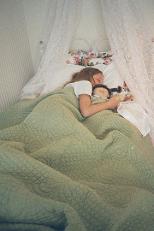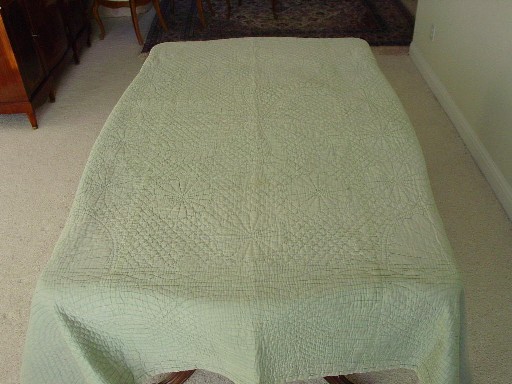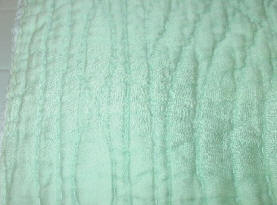|
It is a well-known fact
that in general, quilters are warm and sharing people. This applies to both
quilt makers and quilt collectors. Mary S, from Folsom, California, shared a
wonderful example of this with me, and I thought you would enjoy it, too. Like
the thought of a quilt, it will bring a smile to your face.
I have been very pleasantly surprised at the warmth of quilters, the sharing
of quilting stories and quilting expertise. I would like to share a lovely
quilting story with you. It was one of the reasons I decided to quilt.
 "I saw a Durham quilt in a museum in England and was quite taken with it. My
Grandfather was English and had lived in Yorkshire. I wanted an English quilt to
remember him by and I advertised for a Durham quilt on a U.K. Internet site. I
never heard from anyone and forgot all about the ad. Six months passed and it
was now about the first of December and I finally received a response from an
English woman who had a Durham quilt, and was I still interested? Of course, I
replied, "Would you tell me about the quilt and the price you are
asking?" I was told the quilt was light green cotton, a whole cloth quilt
and thought to be about a 100 years old. Price was not mentioned. It was agreed
a photo was to be sent. We chatted back and forth about ourselves and found we
had many things in common and both were grandmothers. I was expecting a picture
of the quilt, but instead received two lovely pictures of her garden. The lady
said she lived in a large old house with a fantastic garden that she dearly
loved. She worked with the disadvantaged in Hull, England. Her children were
grown and she was filling in her time learning to use the Internet. "I saw a Durham quilt in a museum in England and was quite taken with it. My
Grandfather was English and had lived in Yorkshire. I wanted an English quilt to
remember him by and I advertised for a Durham quilt on a U.K. Internet site. I
never heard from anyone and forgot all about the ad. Six months passed and it
was now about the first of December and I finally received a response from an
English woman who had a Durham quilt, and was I still interested? Of course, I
replied, "Would you tell me about the quilt and the price you are
asking?" I was told the quilt was light green cotton, a whole cloth quilt
and thought to be about a 100 years old. Price was not mentioned. It was agreed
a photo was to be sent. We chatted back and forth about ourselves and found we
had many things in common and both were grandmothers. I was expecting a picture
of the quilt, but instead received two lovely pictures of her garden. The lady
said she lived in a large old house with a fantastic garden that she dearly
loved. She worked with the disadvantaged in Hull, England. Her children were
grown and she was filling in her time learning to use the Internet.
"I asked her if she collected anything special and she replied, "anything
beautiful." She also said she had received so many gifts from friends that
she didn't need the quilt and would like to just give it to me as a gift. She
told me. "If you want to feel rich, just count all the things you have that
money can't buy."
"The quilt arrived a few days before Christmas. As the postman came up my walk, I
was sure this was the quilt. The parcel was wrapped in brown paper and tied with
string and some tape the post office had added. I gently opened the paper to
reveal the quilt and out tumbled rose petals, dried flowers that appear to be
tiny fuchsias, and some small green leaves. Not only did I receive a quilt, but
had been sent part of her garden.
"The quilt is a little faded, slightly worn, mint green, and backed in soft
lavender. You can see it has warmed many people these last 100 years. It is one
of the nicest Christmas gifts I have ever received. We are so afraid of
strangers these days and what we will find on the Internet, or in our own
backyard. To be the recipient of such generosity restores my faith in people.
This quilt is very special. It will warm generations of my family, not just with
its soft worn cloth, but with the gentle kindness it represents. This for me is
Christmas, and by the way, her name was Mary."
Doesn't that just touch your heart! It also touched my mind stimulating a
desire to learn more about quilts made in Durham. Durham is both a town and a
county in Northeastern England, referred to as the North Country region.
Professional quilters were employed in there and it has long been associated
with beautiful quilting. These quilts are made of one piece of fabric, (or two
or three widths sewn together to look as one), not patchwork, and the quilting
is the only adornment. Certain geographical areas are known to emphasize
particular quilt patterns. I wanted to know if this was true in Durham, and if
so, what would distinguish them from other quilts in the region. I turned to
three resident English quilters, with historian eyes to the past, for
information and to Dorothy Osler's,
North Country Quilts: Legend and
Living Tradition, which accompanied the 2000 exhibit at the
Bowes Museum in
Durham.
In the
January 26, 2004 Nine Patch News issue, I shared what I found out, as well
as offered links to pictures of Mary's quilt. It is green on one side, light lavender on the reverse. The quilting pattern can
be described as medallion style since it has a center focus with multiple border
designs surrounding it. It measures 78"x 94", is filled with cotton
bat, and has been used and washed over the years.

Mary
told her she purchased it years ago at a "jumble sale" in Hull. Hull
was a major fishing town, located at the mouth of the Humber, leading to the
North Sea. If driving, Hull lies more than 100 miles south of County Durham, in
Yorkshire. Many traveled by sea from Hull to the northeast region of England.
County Durham and the city of Durham are within this region, called the North
Country. These maps will help to clarify. http://www.visitbritain.com/usa/maps/map_enc_cr.htm
and http://www.visitbritain.com/usa/maps/tiles/north_east.htm
To answer my burning questions -- "When was Mary's quilt made, and what makes a
quilt a Durham quilt (or if there such a thing)?," I turned to my English internet
friend Sally Ward. She in turn asked two English quilt history experts, Barbara Chainey and Lilian
Hedley. Together with the assistance of Dorothy Osler's,
North Country Quilts: Legend and
Living Tradition,
some interesting discussions took place about the whens and whys of
Mary's quilt. They were gracious with their time and expertise and up to the challenge at
hand.
Estimating the age of a quilt with no printed fabrics and whose only design
is the quilting stitches can be a tough job for even the most experienced quilt
historian. I started with Great Britain's documentation project book "Quilt
Treasures of Great Britain." Pauline Adams and Bridget Long explain that it
is rare to find a quilt of this type, signed or dated. The North Country style of
whole-cloth quilt patterns developed from the early structured frame quilts
(medallion in American terms). Over time, they became looser in their layout,
but kept the center focus. Around 1870 - 1880, in the north of England only, there
was a "virtual abandonment" of the central motif and borders style and
an introduction of feathered motifs. Mary's quilt has a six plume feathered star
in the middle, with three roses, which are shaped like the Dresden Plate quilt
block. Three are placed in a pyramid shape above and below the center.
Immediately, Barbara Chainey and Lilian Hedley, exclaimed that a princess
feather in the center indicates this quilt was made in the Northeastern quilting
tradition, and probably in the 20th century. And this was before they saw the
pictures -- I told you they were experts! Sally Ward points to Dorothy Osler's
findings in her first book "Traditional British Quilts." Dorothy
writes that a quilted central princess feather was more common to American
quilters then the English. The North Country quilters were more likely to have a
star in the center then a princess feather, but it was not uncommon to find a
quilted feather of some sort. More often, as Britain's documentation project
also found, the English liked to appliqué a princess feather in the center.
After seeing the pictures, Barbara felt
this beautiful quilt was an example of an "everyday quilt made in the North East
of England, ca 1920 - 1930." This quilt represents a typical style in that day
and would not date past 1940. The individual quilted patterns were few but large
in scale, with a design featured in the center. Roses and cables were placed
along the outside edges, with fans or quarter roses filling in the center's
corners. The feathers, she explains, are not as full and ornate as one might
expect on a quilt made in Durham. She goes on to tell us that it is impossible
to state categorically whether or not it was made in Durham. The simplicity of
the other motifs, rather sparingly quilted across the top, are of notice to
Barbara's keen eyes, telling her the quilt maker was likely to have designed and
drafted the pattern, as well as marked it on the quilt top herself. Although
this was not uncommon in England, a cottage industry of professional pattern
makers and markers emerged around World War I. They marked quilt patterns on the
tops for the quilt maker to quilt. Some of these designing women were known by
their particular designs, so much so that a trained eye could identify the
designer by looking at a quilt. (See Dorothy's
North Country Quilts: Legend and
Living Tradition, for
more information on this. It was published jointly by The
Bowes Museum and
Friends of Bowes Museum, in 2000. The museum is in Durham, UK. Amazon shows
Dorothy's book is out of
print.)
Lilian is able to describe the templates that were used to mark the pattern:
"outer border, large cable, smaller inner border, spectacles, corners,
fans, central field large Prince of Wales feathers, surrounded by daisies in a
sea of square diamonds (cross hatching)." She suggests an earlier age for
this quilt, 1900 - 1915. The "hey day" for the "Prince of Wales
feather" pattern was between 1890 and the First World War, which began in
England in 1914. Women took over men's jobs, and quilting waned after that. Of
course, this does not mean a quilter could not make this quilt later, but she
has seen around "360 quilts at Beamish Museum and a few have this pattern,
but they are all pre-war." Lilian suggests this may be a "Club
quilt" made by groups of widowed women who made quilts to earn their
living. They quilted all day and into the night. "Running a club was akin to
slave labor," Lilian has been told by daughters and granddaughters of these
women. They never wanted to pick up a needle after watching their mothers quilt
in these clubs.

The experts agree that the term "Durham quilt" has been over used
and at times incorrectly used by dealers and quilters to describe any quilt
made in northeastern England. Lilian says, "In reality there is no such
thing as a Durham quilt, as the style and templates are common right from the
borders of Scotland down to the middle of Yorkshire."
Then how did this 'style name' (my words) come to be? Lilian explains,
"The phrase Durham quilt came about at the end of the Twenties, during the
Depression. The Rural Industries Board decided if they could not find work for
the men, they would find some for the woman, and they chose quilting. All of the
women chosen not only had to be good quilters, they were means tested to go on
the scheme. Claridges Hotel in London gave them a large order for silk quilts,
and the headlines in the London papers said, 'Durham Quilts for Claridges,' and
ever since everything from the north has been called a Durham quilt."
A quote from Dorothy's, "North Country Quilts: Legend and
Living Tradition," provides more
possible roots of this phrase: "The momentum built up by the Women's
Institute to revive the declining craft of quilting was brought to an abrupt
halt with the outbreak of war. But a lasting legacy of this inter-war period is
the appellation 'Durham quilt' for a North Country style. Quite how it evolved
is a mystery. It may have come from the term used by the London galleries to
distinguish their quilts made in County Durham from those produced in South
Wales. Equally, it may have been introduced by the WI. Whatever the source,
'Durham quilting' became firmly entrenched in the quilting vocabulary and has
remained ever since."
It seems the phrase began in England, within the second quarter of the 20th
century and was incorrectly used as a style name by non-quilters to
distinguish them from those made in regions other than Northeastern England.
 Another aspect of the quilt that interested our experts was the fabric
itself. Was it a cotton as reported, a sateen, or was it both? There was a twill
weave of mercerized cotton, known as Roman Sateen, that was popular with North
Country quilt makers more than 50 years ago. A soft sheen remained through
multiple washings done at home but was dulled when dry or industrial machine
cleaned. This quilt, with Roman Sateen on both the front and back, was likely
dulled in this way and therefore looks more like cotton. Mary took a closer
look after hearing this and could still see a subtle shine in certain lights. Another aspect of the quilt that interested our experts was the fabric
itself. Was it a cotton as reported, a sateen, or was it both? There was a twill
weave of mercerized cotton, known as Roman Sateen, that was popular with North
Country quilt makers more than 50 years ago. A soft sheen remained through
multiple washings done at home but was dulled when dry or industrial machine
cleaned. This quilt, with Roman Sateen on both the front and back, was likely
dulled in this way and therefore looks more like cotton. Mary took a closer
look after hearing this and could still see a subtle shine in certain lights.
Mary's quilt has a knife edge, in lieu of a binding. This edge is formed when
the front and back edges are turned inside ¼" to ½" and the folded
edge is slip or ladder stitched closed. Leaving no stone unturned, our experts
pointed to the knife edging as one more clue to it being made in the North
Country.
Thank you Ladies, for making this case study possible and so interesting. And
a "Thank you!" to the two Mary's for bringing their North Country 20th century Roman
Sateen quilt into all of our lives. When Mary sent the quilt from England, she
included pictures of her garden and this note: "Like gardeners, quilters
have big hearts. Quilts are about warmth and protection, they serve as shelters
from the harsher bits of life, just as gardens provide a space to dream and
ponder. Best wishes, Mary."
English Quilts and Quilters appeared in the NPN October 25, 2003 issue.

New book . . .
A Collection of Durham Quilts (Paperback)
by Muriel Martin
|